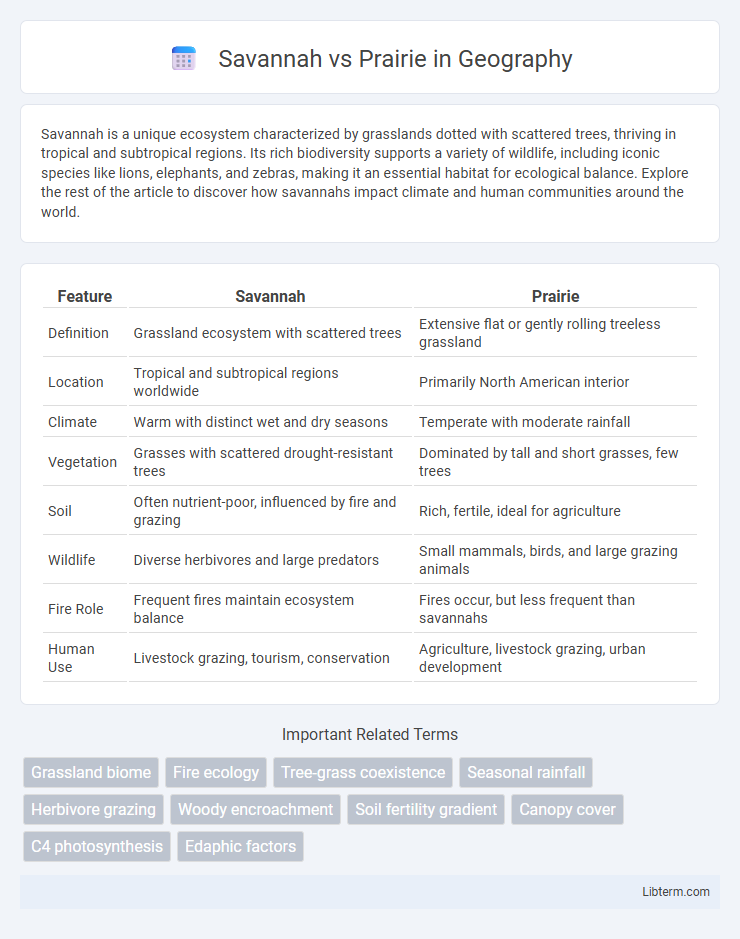Savannah is a unique ecosystem characterized by grasslands dotted with scattered trees, thriving in tropical and subtropical regions. Its rich biodiversity supports a variety of wildlife, including iconic species like lions, elephants, and zebras, making it an essential habitat for ecological balance. Explore the rest of the article to discover how savannahs impact climate and human communities around the world.
Table of Comparison
| Feature | Savannah | Prairie |
|---|---|---|
| Definition | Grassland ecosystem with scattered trees | Extensive flat or gently rolling treeless grassland |
| Location | Tropical and subtropical regions worldwide | Primarily North American interior |
| Climate | Warm with distinct wet and dry seasons | Temperate with moderate rainfall |
| Vegetation | Grasses with scattered drought-resistant trees | Dominated by tall and short grasses, few trees |
| Soil | Often nutrient-poor, influenced by fire and grazing | Rich, fertile, ideal for agriculture |
| Wildlife | Diverse herbivores and large predators | Small mammals, birds, and large grazing animals |
| Fire Role | Frequent fires maintain ecosystem balance | Fires occur, but less frequent than savannahs |
| Human Use | Livestock grazing, tourism, conservation | Agriculture, livestock grazing, urban development |
Introduction to Savannahs and Prairies
Savannahs are ecosystems characterized by a mix of open grasslands and scattered trees, primarily found in tropical and subtropical regions like Africa and Australia. Prairies, located mainly in North America, are vast grasslands with few trees, dominated by tall grasses and rich in biodiversity. Both savannahs and prairies support diverse wildlife and play critical roles in carbon sequestration and soil conservation.
Defining Features of Savannahs
Savannahs are characterized by a mix of grasslands and scattered trees, typically dominated by species such as acacias and baobabs, which creates a semi-open canopy that allows sunlight to reach the grassy understory. This ecosystem experiences a distinct wet and dry season, supporting diverse wildlife including large herbivores like elephants and zebras, unlike prairies which consist primarily of continuous grasses with few or no trees. Savannah soils are often well-drained and nutrient-poor, influencing the vegetation structure and fire regimes essential for maintaining the balance between trees and grasses.
Defining Features of Prairies
Prairies are characterized by vast grasslands dominated by herbaceous plants, with minimal tree coverage, typically found in temperate regions. These ecosystems support deep, nutrient-rich soils that promote the growth of tall grasses such as big bluestem, switchgrass, and Indian grass, providing habitat for a variety of wildlife like bison, prairie dogs, and numerous bird species. Prairies experience seasonal variations, including hot summers and cold winters, which contribute to the unique plant adaptations and biodiversity distinctive to these grasslands.
Climate Differences
Savannahs experience a tropical climate characterized by distinct wet and dry seasons, with temperatures typically ranging between 20degC to 30degC and annual rainfall between 750 to 1200 mm. Prairies, on the other hand, have a temperate climate marked by cold winters and hot summers, receiving annual precipitation between 300 to 900 mm, often in the form of snow during winter months. These climate differences influence the types of vegetation and wildlife adapted to each biome, with savannahs supporting drought-resistant grasses and scattered trees, while prairies are dominated by tall and short grasses suited to temperature extremes.
Soil Composition and Fertility
Savannah soils typically exhibit a mix of sandy and loamy textures with moderate organic matter, offering good drainage and adequate nutrient availability for grasses and scattered trees. Prairie soils are predominantly rich mollisols, characterized by deep, dark, humus-rich topsoil with high fertility and excellent moisture retention, supporting dense grassland vegetation. The higher organic content and nutrient cycling in prairies generally result in more fertile soil compared to the often more acidic and less nutrient-dense savannah soils.
Types of Vegetation
Savannahs feature a mix of tall grasses and widely spaced trees such as acacias and baobabs, promoting a balance between open grassland and scattered woody plants. Prairies predominantly consist of dense, herbaceous grasses like bluestem, buffalo grass, and switchgrass, with very few trees or shrubs due to frequent fires and grazing. The distinct vegetation types in savannahs and prairies reflect adaptations to varying precipitation levels, fire regimes, and soil conditions.
Common Animal Life
Savannahs host diverse wildlife such as lions, elephants, zebras, and various antelope species adapted to open grasslands with scattered trees. Prairie ecosystems are dominated by herbivores like bison, pronghorn, and prairie dogs, complemented by predators such as coyotes and hawks within vast treeless grasslands. Both habitats feature specialized animal communities evolved to thrive in their distinct climates and vegetation structures.
Ecosystem Roles and Biodiversity
Savannahs serve as transitional ecosystems featuring scattered trees and grasslands that support diverse herbivores and predators, maintaining a balance through grazing and fire regimes. Prairies, dominated by tall grasses with minimal tree cover, provide habitat for a vast array of pollinators, small mammals, and ground-nesting birds, contributing significantly to soil health and nutrient cycling. Both ecosystems play critical roles in carbon sequestration, water regulation, and sustaining regional biodiversity through distinct but complementary species assemblages.
Human Impact and Land Use
Savannahs experience human impact primarily through agricultural expansion, livestock grazing, and urban development, which often lead to habitat fragmentation and biodiversity loss. Prairies face similar pressures from intensive farming, land conversion for crop production, and infrastructure development, resulting in soil degradation and reduced native plant cover. Both ecosystems require sustainable land management practices to mitigate negative effects and preserve ecological balance.
Conservation Challenges and Strategies
Savannah ecosystems face conservation challenges such as habitat fragmentation, invasive species, and overgrazing, requiring strategies like controlled burns and protection of keystone species to maintain biodiversity. Prairie conservation struggles with agricultural expansion, soil degradation, and loss of native plant diversity, addressed through practices like rotational grazing, restoration of native grasses, and establishment of protected reserves. Both biomes depend on adaptive management and community involvement to sustain their ecological functions and resilience.
Savannah Infographic

 libterm.com
libterm.com